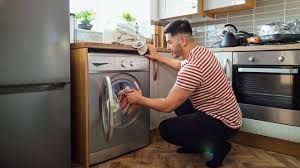Why Is My Maytag Washing Machine Not Spinning?
A washing machine that doesn’t spin can be frustrating, especially when you're dealing with a pile of dirty laundry that needs to be cleaned and dried. If you own a Maytag washing machine and are experiencing issues with the spin cycle, you're not alone. This problem is common, but fortunately, it can often be resolved with a bit of troubleshooting. In this guide, we’ll explore the potential reasons why your Maytag washing machine isn’t spinning and what you can do to fix it.
Power Supply Issues
Before diving into more complex troubleshooting, it's important to ensure that your washing machine is receiving power. Sometimes, the problem is as simple as a loose power cord or a tripped circuit breaker.
- Check the Power Cord: Make sure the power cord is securely plugged into the outlet. If it’s loose, it could cause intermittent power loss, leading to issues with the spin cycle.
- Inspect the Circuit Breaker: If your washing machine suddenly stops spinning, the circuit breaker may have tripped. Reset the breaker if necessary.
- Test the Outlet: Plug another appliance into the same outlet to see if it’s functioning properly. If the outlet isn’t working, you may need an electrician to fix it.
Lid Switch Assembly Problems
The lid switch assembly is a safety feature that prevents the washing machine from spinning when the lid is open. If the lid switch is faulty, the machine may think the lid is open even when it’s closed, causing the spin cycle to fail.
- Listen for a Click: When you close the lid, you should hear a click sound, indicating that the lid switch has been activated. If you don’t hear the click, the switch may be defective.
- Test the Lid Switch: Use a multimeter to test the lid switch for continuity. If the switch is faulty, it will need to be replaced.
Drive Belt Issues
The drive belt is responsible for turning the drum during the spin cycle. Over time, the belt can become loose, frayed, or even break, preventing the drum from spinning.
- Inspect the Drive Belt: Unplug the washing machine and remove the back panel to access the drive belt. Look for signs of wear or damage. If the belt is loose or broken, it will need to be replaced.
- Tighten the Belt: If the belt is loose but not damaged, you may be able to tighten it by adjusting the motor mounting bolts. However, if the belt is worn out, replacement is the best option.
Motor Coupling Failure
The motor coupling connects the motor to the washing machine’s transmission. This small, plastic part is designed to break if the washer is overloaded, protecting the motor and transmission from damage. If the motor coupling is broken, the washer will not spin.
- Check the Motor Coupling: To inspect the motor coupling, you’ll need to remove the washer’s cabinet. If the coupling is broken, you’ll see broken plastic pieces or a disconnection between the motor and transmission.
- Replace the Motor Coupling: Fortunately, motor couplings are relatively inexpensive and can be replaced with basic tools.
Clogged or Malfunctioning Drain Pump
The drain pump is responsible for removing water from the drum before the spin cycle begins. If the pump is clogged or malfunctioning, the washer may not spin because it cannot drain properly.
- Check for Clogs: Unplug the washing machine and locate the drain pump. Remove any debris or objects that may be clogging the pump or the drain hose.
- Listen for Pump Operation: When the washer reaches the drain cycle, listen for the sound of the pump running. If you don’t hear it, the pump may be malfunctioning and need to be replaced.
- Inspect the Drain Hose: Ensure that the drain hose is not kinked or clogged. A blocked hose can prevent the water from draining, which in turn stops the spin cycle.
Worn Out or Damaged Clutch Assembly
The clutch assembly helps the washer drum reach the proper spin speed. If the clutch is worn out or damaged, the drum may not spin at all, or it may spin slowly.
- Inspect the Clutch Assembly: The clutch assembly is usually located near the bottom of the washing machine. Look for signs of wear or damage, such as a burnt smell or a grinding noise during the spin cycle.
- Replace the Clutch Assembly: If the clutch is worn out, it will need to be replaced. This is a more involved repair that may require professional assistance if you're not comfortable with appliance repair.
Faulty Drive Motor
The drive motor is what powers the spinning action of the drum. If the motor is faulty, the washer will not spin. This could be due to a burned-out motor, electrical issues, or problems with the motor windings.
- Test the Drive Motor: Use a multimeter to check for continuity in the motor windings. If the motor is burned out or not functioning correctly, it will need to be replaced.
- Listen for Unusual Sounds: A failing drive motor may produce a humming or buzzing sound, indicating that it’s struggling to operate.
Transmission Issues
The transmission is responsible for shifting the washer from agitation mode to the spin cycle. If the transmission is faulty, the washer may agitate but not spin.
- Check for Transmission Noise: A failing transmission may produce loud noises during the spin cycle or cause the washer to agitate erratically.
- Transmission Replacement: Replacing the transmission is a complex and costly repair. If the transmission is the issue, you may need to weigh the cost of the repair against the cost of replacing the washing machine.
Unbalanced Load
An unbalanced load can prevent the washer from spinning properly. If the laundry inside the drum is unevenly distributed, the washer’s sensors may stop the spin cycle to prevent damage.
- Redistribute the Load: Pause the washing machine and open the lid. Redistribute the clothes evenly around the drum and close the lid. Restart the spin cycle to see if the problem is resolved.
- Avoid Overloading: Always avoid overloading the washer. Overloading can cause unbalanced loads, leading to spin cycle issues and potential damage to the machine.
Control Board Malfunction
The control board is the brain of the washing machine, controlling all its functions. If the control board is malfunctioning, it may not send the correct signals to start the spin cycle.
- Check for Error Codes: Many modern Maytag washers display error codes when something goes wrong. Refer to your user manual to interpret any error codes that appear on the display.
- Inspect the Control Board: If you suspect the control board is the issue, visually inspect it for burnt components or loose connections. In some cases, the control board may need to be replaced.
Faulty Timer
The timer controls the length of each cycle, including the spin cycle. If the timer is defective, it may not advance to the spin cycle, or it may not run the spin cycle for the correct amount of time.
- Test the Timer: Use a multimeter to check the continuity of the timer contacts. If the timer is faulty, it will need to be replaced.
Brake Assembly Issues
In some top-loading Maytag washers, the brake assembly is responsible for stopping the drum from spinning when the cycle is complete. If the brake assembly is faulty, it can engage prematurely or fail to disengage, preventing the drum from spinning.
- Inspect the Brake Assembly: If you hear grinding or squealing noises during the spin cycle, the brake assembly may be the culprit. Replacing the brake assembly is a complex repair that may require professional assistance.
Water Level Control Issues
The water level control, also known as the pressure switch, determines how much water is in the drum. If the control is faulty, it may prevent the washer from advancing to the spin cycle because it thinks the drum is still full of water.
- Test the Pressure Switch: Use a multimeter to test the pressure switch for continuity. If it’s faulty, the switch will need to be replaced.
- Inspect the Pressure Hose: Ensure that the pressure hose connected to the switch is not kinked, clogged, or damaged.
Washing Machine Spinning Smoothly
A Maytag washing machine that isn’t spinning can be caused by a variety of issues, ranging from simple fixes like redistributing the load to more complex repairs like replacing the transmission. By systematically troubleshooting each potential cause, you can often diagnose and fix the problem without the need for professional repair services. However, if the issue is beyond your expertise or if you're not comfortable performing certain repairs, it's always a good idea to consult a professional technician. Regular maintenance and proper use of your washing machine can also help prevent future spin cycle issues, ensuring that your Maytag washer continues to perform efficiently for years to come.
You might also like
Educational Center
Book a Service Today
We will get back to you as soon as possible
Please try again later
Quick & Reliable
We are available 24/7
About Us
Authorized Appliance is an appliance repair contractor referral service. We connect you with appliance contractor in your area. All contractors are operated independently of Authorized Appliance. It is the responsibility of each user to verify that the contractor connected with meets all licensing and insurance requirements in that jurisdiction.
All Rights Reserved - Authorized Appliance




